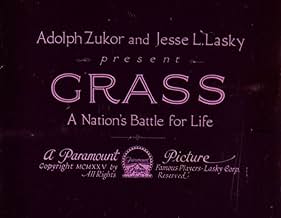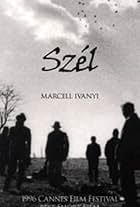IMDb RATING
7.7/10
1.3K
YOUR RATING
The struggles of a hardscrabble Iranian nomadic tribe as they journey through bleak country to reach the grasslands that will save their livestock.The struggles of a hardscrabble Iranian nomadic tribe as they journey through bleak country to reach the grasslands that will save their livestock.The struggles of a hardscrabble Iranian nomadic tribe as they journey through bleak country to reach the grasslands that will save their livestock.
- Directors
- Writers
- Stars
- Awards
- 1 win total
- Directors
- Writers
- All cast & crew
- Production, box office & more at IMDbPro
Featured reviews
This was soul-provoking! I am an Iranian, and living in th 21st century, I didn't know that such big tribes have been living in such conditions at the time of my grandfather!
You see that today, or even in 1925, on one side of the world a lady or a baby could have everything served for him or her clean and on-demand, but here 80 years ago, people ventured their life to go to somewhere with more grass. It's really interesting that these Persians bear those difficulties to find pasture for their sheep, but they lose many the sheep on their way.
I praise the Americans who accompanied this tribe, they were as tough as Bakhtiari people.
You see that today, or even in 1925, on one side of the world a lady or a baby could have everything served for him or her clean and on-demand, but here 80 years ago, people ventured their life to go to somewhere with more grass. It's really interesting that these Persians bear those difficulties to find pasture for their sheep, but they lose many the sheep on their way.
I praise the Americans who accompanied this tribe, they were as tough as Bakhtiari people.
The first collaboration between Schoedsack & Cooper is a compelling documentary on the migration of the Bakhtiari tribe of Persia. Twice a year, more than 50,000 people and half a million animals cross rivers and mountains to get to pasture. You'll feel like a pampered weakling after watching these people herd their animals through ice cold water and walk barefoot through the snow to cross the mountains while trying to get their animals to walk along steep and narrow mountain paths.
Fantastic documentary of 1924. This early 20th century geography of today's Iraq was powerful. Watch this and tell me if Cecil B. DeMille didn't take notes before making his The Ten Commandments. Merian C. Cooper, the photographer, later created Cinerama, an idea that probably hatched while filming the remarkable landscapes in this film. Fans of Werner Herzog will find this film to be a treasure, with heartbreaking tales of struggle, complimented by the land around them, never has the human capacity to endure been so evident. The fact that this was made when it was shows not only the will of the subjects, but of the filmmakers themselves.
The team of Merian Cooper and Ernest Schoedsack produced a documentary of 50,000 Bakhtiari people and their animals on the Summer migration to winter grazing. The basic worth of this film today is as a time capsule of a "forgotten people" and how they lived during what we in the West knew as the "roaring twenties." A more drastic contrast could not be imagined. Raging river and barefoot mountain crossings are brutally realistic and the animals that disappear under the water do in fact die. To make sure that the audience of the time believed that the story took place, a signed certificate of authenticity is offered up at the end. The version that I saw had fascinating Iranian music that can stand alone and be appreciated without the film. Having said all this, the film is probably of more value to the anthropologist than the casual viewer in search of a good evening's entertainment. The crew had just barely sufficient stock to take the shots that they recorded and there is no fancy camera work resulting from multiple re-takes. The Western inter-titles detract from the experience but are in fact a part of the record since they demonstrate how Hollywood tried to put their spin on the lives of an indigenous peoples lives so that they would be appreciated by the audience of the day. Off-duty entertainment by desert police becomes a "policeman's ball." The producers went on to make the docu-drama Chang (1927) and the totally commercial King Kong (1933). The migration theme is used again in People of the Wind (1976) and in Himalaya (1999). Recommended for those who know in advance what they are getting into -- and then highly recommended for them.
They probably could have skipped some of the beginning - I'm not sure why this starts out in the Asian part of Turkey. If it was because starting in the Mediterranean, they could have gotten closer starting in modern day Lebanon.
One the cameras and crews get to the Bakhtyari tribe, it's the beginning of an amazing 48 day journey. 50,000 people with about 250,000 goats, camels, cattle, and horses make this amazing trek across what seems to be a very fast moving Karun River. They use rafts that are kept afloat by inflating goat skins - you can see where the head and legs were removed. The other "bank" of the river was very steep - I'm guessing about a 60 degree rise.
Just watching that was incredible, but there was much more to come. To get to the pastures, they also had to cross a major mountain that had about 4 feet of snow, if not more. Being able to climb this mountain was pretty amazing in and of itself, but they (and all of the animals) climbed this mountain barefoot! Yes, barefoot.
The one drawback to this documentary were some of the inter-titles with poor attempts at humor.
If you want to see a documentary from the silent era, or the incredible challenges that this tribe not only face, but conquer. This is just an incredible document of a little known group of people facing all kinds of challenges.
One the cameras and crews get to the Bakhtyari tribe, it's the beginning of an amazing 48 day journey. 50,000 people with about 250,000 goats, camels, cattle, and horses make this amazing trek across what seems to be a very fast moving Karun River. They use rafts that are kept afloat by inflating goat skins - you can see where the head and legs were removed. The other "bank" of the river was very steep - I'm guessing about a 60 degree rise.
Just watching that was incredible, but there was much more to come. To get to the pastures, they also had to cross a major mountain that had about 4 feet of snow, if not more. Being able to climb this mountain was pretty amazing in and of itself, but they (and all of the animals) climbed this mountain barefoot! Yes, barefoot.
The one drawback to this documentary were some of the inter-titles with poor attempts at humor.
If you want to see a documentary from the silent era, or the incredible challenges that this tribe not only face, but conquer. This is just an incredible document of a little known group of people facing all kinds of challenges.
Storyline
Did you know
- TriviaDuring the treacherous traversing of the Karun River, animals are shown struggling and actually drowning.
- Goofs(at around 31 mins) The title card states "All the fifty thousand of the Bakhtyari must go the way of Haidar ..." A couple minutes later, a title card states "The tramp of fifty thousand feet!" Either the number of feet should be doubled or the number of Bakhyari halved.
- Quotes
Opening Title Card: The way of the world is west.
- Alternate versionsMilestone Film & Video released a version in 1991 with a new score produced by Richard Einhorn and running 71 minutes.
- ConnectionsFeatured in The Last Outpost (1935)
Details
Box office
- Budget
- $12,000 (estimated)
- Runtime1 hour 11 minutes
- Color
- Sound mix
- Aspect ratio
- 1.33 : 1
Contribute to this page
Suggest an edit or add missing content

Top Gap
By what name was Grass: A Nation's Battle for Life (1925) officially released in Canada in English?
Answer
























